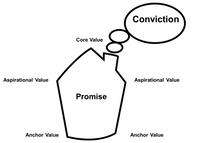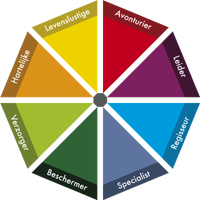BrandHouse© en BrandPositioner©
BrandHouse©
To effectively engage the entire organization with the brand, it is crucial to articulate the chosen position clearly and powerfully. The BrandHouse© model succinctly captures the brand's essence, making it instantly understandable to everyone and serving as an internal compass. Through its attractive and tension-filled presentation, the brand captivates both customers and employees.
The BrandHouse© consists of three elements: conviction (the brand's socio-economic ambition), brand promise (the emotional benefit of using the brand), and brand values (which collectively describe the brand's character).
From the book: 'The Success of Internal Branding' by Marc van Eck, Ellen Leenhouts, and Linda Rutten
Conviction
Conviction is the 'why' of the brand house. It describes why the organization exists; the higher purpose of the organization. It indicates why the organization undertakes activities. Conviction is socially relevant, but it can also be debated. So, it inspires some but not everyone. Conviction is never so general that it becomes brandless. The conviction reflects the character that the brand inherently possesses. It is also never so specific that it becomes function or category-bound.
Brand Promise
The brand promise describes the 'what' of the brand house. This is not the functional 'what' but the emotional 'what'. The promise is about what the organization offers to the (internal) customer. What does the brand evoke in customers? The brand promise emotionally appeals to customers and also internally guides the 'what' of the organization. The promise strongly influences the services (including innovation) developed by the brand and offered to the customer. Additionally, (an element of) the promise is conveyed in communication and the tagline, with or without a suitable proposition.
Brand Values
The brand values describe the 'how' of the brand house. The brand values are the compass for the organization but not the GPS with specific coordinates. They provide direction while offering space simultaneously. The brand house consists of five brand values: two anchor values, two aspiration values, and one self-value. They guide how the organization does things.
The anchor values are embedded in the organization's DNA. They represent where you come from. However, effort must be continuously invested to maintain them. Anchor values are often broadly defined.
The self-value most accurately represents how the organization does things.
Aspiration values complete the whole picture. These are values that potentially exist within the organization. You need to work a bit harder to make them visible. Aspiration values guide the movement the organization wants to make and keep the other values in check so that the brand doesn't veer off course by exaggerating its strong values.
The tension between the values makes the brand appealing to people. This means that a value never stands alone, but it's always about the coherence of the brand values. The brand values align with the positioning direction. A good set of values has both significant satisfiers (usually found in anchor values) and delighters (self-value and aspiration values). The values are derived from the chosen and adjacent positions of the BrandPositioner© model. The values are formulated sharply to provide intuitive guidance. An individual value doesn't necessarily have to be unique or distinctive, but the combination of values must be.
If an organization consistently lives up to its values in everything it does (communication, symbols, systems/processes, products, and behavior), customers recognize the organization by its values. This is the ultimate litmus test.
BrandPositioner©
Strong brands are known to be based on a specific primal character, an archetype. The BrandPositioner© model developed by Business Openers helps determine the archetype. A clear brand positioning from one of these archetypes enhances the brand's recognizability and trust because people are unconsciously familiar with it.
From the book: 'Het succes van Internal Branding' by Marc van Eck, Ellen Leenhouts en Linda Rutten

